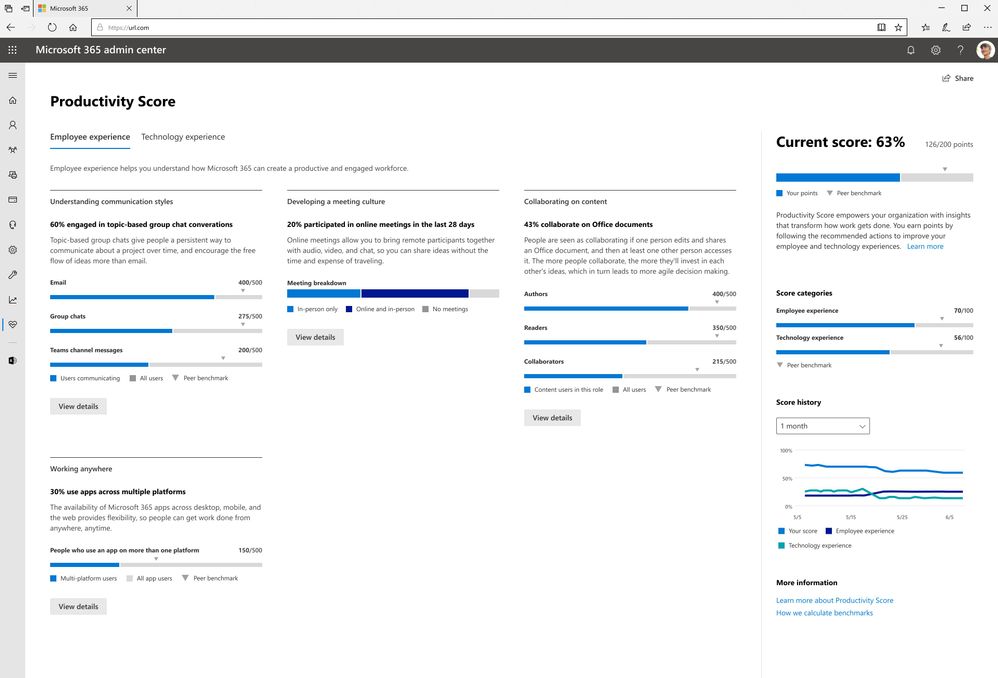Wouldn’t it be great to have insights into how productive your team is being? You could check how often they’re using certain tools to make better decisions about business investments or examine which employees you need to engage more effectively.
Microsoft Productivity Score is one of the more recent and controversial arrivals in the Microsoft ecosystem. Aiming to provide visibility into your employees’ experience so you can improve efficiency and empowerment in the workforce, the score is sure to appeal to plenty of business leaders.
However, the response to the arrival of Productivity Score has been mixed. Many misinformation ended up online, with disgruntled users complaining that the scoring system was akin to “workplace surveillance”. But is Microsoft’s new feature really a “Big Brother” functionality?
What is Microsoft Productivity Score
Microsoft Productivity Score is all about giving businesses “insights” into where they are on their digital transformation journey. According to Microsoft, the score aims to show you how much your employees are really using various tools, and how you can work to improve team experience.

The Productivity Score uses metrics, insights, and recommended actions designed to support companies in generating better results from their teams. Primarily, Productivity Score focuses on people experiences, technology experiences, and “special reports”.
Your overall productivity score is based on the combined score of your people and technology experience categories, with the highest potential score falling at 800.
So, what’s the problem?
The people who don’t like the idea of the Productivity Score see it as an invasion of privacy, or a workplace surveillance scheme intended to keep employees in line. However, many of the experts who have called Microsoft out for this feature are supporters of similar functionality elsewhere.
Microsoft argues that the Productivity Score was never intended as an employee monitoring tool. However, even if it were, it wouldn’t be the first system out there to offer this functionality. There are plenty of companies that want the option to keep track of how productive and effective their staff members are being. Products like Controlio and ActivTrak are a testament to this.
What Does Microsoft Productivity Score Really Do?
The reality is that Microsoft Productivity Score offers a very similar experience to the reporting capabilities on other marketplace tools like Zoom, Cisco, and Slack. Many collaboration and communication tools allow for adoption and user-level reporting.
To reduce the risk of issues caused by “invasion of privacy”, Microsoft even actively removed some of the features and tracking options that employees might have found worrisome. Today, the Productivity Score tool focuses on:
People Experiences
This reporting segment aims to show how the organisation might be using Microsoft tools to transform their work in collaboration, communication, and meetings. There are five measurement categories here, including:
- Communication: How people share information through chat, email, community posts, and other tools for a unified employee experience
- Content collaboration: How people within the organisation create and collaborate on content in the cloud, wherever they are
- Mobility: How easy it is for team members to access and use files from the Microsoft 365 ecosystem to continue making progress on projects
- Meetings: How the organisation can leverage meeting best practices to improve meeting quality
- Teamwork: How the people in an organisation are using shared environments like Microsoft Teams and SharePoint for collaborative success
Technology Experiences
Technology experience scores from Microsoft help companies to support stronger digital transformation goals by optimizing device performance and network connectivity. The technology experiences area focuses on three categories (at present):
- Endpoint analytics: How organisations are impacted by performance and health issues with endpoint software and hardware. You can also receive recommendations for improvements.
- Network connectivity: Visibility on the factors that may affect your network, combined with suggestions to address problematic areas.
- Microsoft 365 apps health: Insights into the devices that have the best productivity and security components.
Special reports:
The final component of the Microsoft Productivity Score is “special reports”. These are insights that help companies to measure specific changes in the workplace. For instance, you can access reports that demonstrate how well your employees are responding to a shift in remote working.
Is it Really an Invasion of Privacy?
The Microsoft Productivity Score provides basic insights into how your organisation is using various functions and tools to operate in a changing business landscape. You can compare your performance to some peer benchmarks provided by Microsoft, check trends over time for things like technology adoption, and get suggestions on how to improve.
To calculate your score, Microsoft pulls information from all aspects of the Microsoft 365 environment, including Outlook, Teams, Exchange, and SharePoint. Once the system has collected information for your technology and people experiences over a set period of time, it shows you your total score and your performance on your Admin homepage.
While you can dive a little deeper into each of the metrics that Microsoft measures to deliver your people and technology experience scores, the insights are mainly generalized. You can see things like how many people are using Microsoft Teams, or how often people are co-editing online files. Microsoft can also show you how many of your team members are using multiple methods of communication and give you a breakdown of the things you can do to align your workers.
What Microsoft Productivity Score doesn’t do (at any point) is give you a complete rundown of what each individual in your business is doing each day.
Is Productivity Score a Good Idea?
Despite the hyperbolic news stories and panic from people worried about their personal privacy, Microsoft Productivity Score isn’t the surveillance issue that you may think. Ultimately, it’s a convenient way to get an insight into how people and technology are helping your business to evolve. This isn’t a service intended to help you watch your staff at all times.
Instead, Microsoft is giving companies an easy way to see how their business is evolving and discover which areas of experience they need to focus on. That doesn’t seem like a bad thing in our book.







